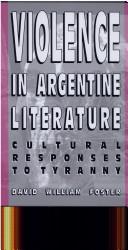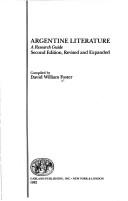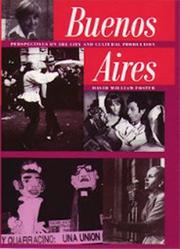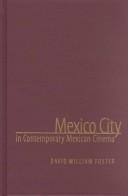| Listing 1 - 10 of 97 | << page >> |
Sort by
|
Book
ISBN: 0824089030 Year: 1985 Volume: vol vol. 511 Publisher: New York
Abstract | Keywords | Export | Availability | Bookmark
 Loading...
Loading...Choose an application
- Reference Manager
- EndNote
- RefWorks (Direct export to RefWorks)
Book
ISBN: 0810808714 Year: 1975 Publisher: Metuchen, N.J.
Abstract | Keywords | Export | Availability | Bookmark
 Loading...
Loading...Choose an application
- Reference Manager
- EndNote
- RefWorks (Direct export to RefWorks)
Fiction --- Spanish-American literature --- anno 1900-1999 --- Spanish American fiction --- History and criticism --- Bibliography

ISBN: 0826209912 Year: 1995 Publisher: Columbia, Mo. University of Missouri Press
Abstract | Keywords | Export | Availability | Bookmark
 Loading...
Loading...Choose an application
- Reference Manager
- EndNote
- RefWorks (Direct export to RefWorks)
Fiction --- Thematology --- Spanish-American literature --- anno 1900-1999 --- Argentina --- Argentine fiction --- Argentine literature --- Literature and society --- Violence in literature --- Fiction argentine --- Litterature argentine --- Littérature argentine --- Violence dans la littérature --- History and criticism --- Political aspects --- Histoire et critique --- Aspect politique --- Violence in literature. --- History and criticism. --- Political aspects. --- Littérature argentine --- Violence dans la littérature

ISBN: 0824093976 9780824093976 Year: 1982 Volume: 338 Publisher: New York (N.Y.): Garland,
Abstract | Keywords | Export | Availability | Bookmark
 Loading...
Loading...Choose an application
- Reference Manager
- EndNote
- RefWorks (Direct export to RefWorks)

ISBN: 0292724829 0292744803 0292733976 Year: 1994 Publisher: Austin, Texas : University of Texas Press,
Abstract | Keywords | Export | Availability | Bookmark
 Loading...
Loading...Choose an application
- Reference Manager
- EndNote
- RefWorks (Direct export to RefWorks)
Mexico has a rich literary heritage that extends back over centuries to the Aztec and Mayan civilizations. This major reference work surveys more than five hundred years of Mexican literature from a sociocultural perspective. More than merely a catalog of names and titles, it examines in detail the literary phenomena that constitute Mexico's most significant and original contributions to literature. Recognizing that no one scholar can authoritatively cover so much territory, David William Foster has assembled a group of specialists, some of them younger scholars who write from emerging trends in Latin American and Mexican literary scholarship. The topics they discuss include pre-Columbian indigenous writing (Joanna O'Connell), Colonial literature (Lee H. Dowling), Romanticism (Margarita Vargas), nineteenth-century prose fiction (Mario Martín Flores), Modernism (Bart L. Lewis), major twentieth-century genres (narrative, Lanin A. Gyurko; poetry, Adriana García; theater, Kirsten F. Nigro), the essay (Martin S. Stabb), literary criticism (Daniel Altamiranda), and literary journals (Luis Peña). Each essay offers detailed analysis of significant issues and major texts and includes an annotated bibliography of important critical sources and reference works.
Mexican literature
---
-#BIBC:ruil

ISBN: 0813021545 9780813021546 0813016134 Year: 1998 Publisher: Gainesville, Fla University Press of Florida
Abstract | Keywords | Export | Availability | Bookmark
 Loading...
Loading...Choose an application
- Reference Manager
- EndNote
- RefWorks (Direct export to RefWorks)
Popular culture --- City and town life --- Arts and society --- Literature and society --- Regions & Countries - Americas --- History & Archaeology --- Latin America --- Literature --- Literature and sociology --- Society and literature --- Sociology and literature --- Sociolinguistics --- Arts --- Arts and sociology --- Society and the arts --- Sociology and the arts --- City life --- Town life --- Urban life --- Sociology, Urban --- Culture, Popular --- Mass culture --- Pop culture --- Popular arts --- Communication --- Intellectual life --- Mass society --- Recreation --- Culture --- Social aspects --- Buenos Aires (Argentina) --- Trinidad del Puerto de Santa María de Buenos Aires (Argentina) --- Buenos Ayres (Argentina) --- Capital Federal (Argentina) --- Trinidad y Puerto de Santa María de los Buenos Aires (Argentina) --- Capital (Argentina) --- Ciudad Autónoma de Buenos Aires (Argentina) --- La Trinidad (Argentina) --- Trinidad (Argentina) --- gobBsAs (Argentina) --- Gobierno de la Ciudad Autónoma de Buenos Aires (Argentina) --- Buenos Aires (Federal Capital) --- CABA (Argentina) --- Autonomous City of Buenos Aires (Argentina) --- Buenos Ajres (Argentina) --- In art. --- In literature. --- Sociology of culture --- Buenos Aires
Book
ISBN: 0822982382 9780822982388 0822964392 9780822964391 Year: 2017 Publisher: Pittsburgh, Pa.
Abstract | Keywords | Export | Availability | Bookmark
 Loading...
Loading...Choose an application
- Reference Manager
- EndNote
- RefWorks (Direct export to RefWorks)
"Mexican-American life, like that of nearly every contemporary community, has been extensively photographed. Yet there is surprisingly little scholarship on Chicano photography. Picturing the Barrio presents the first book-length examination on the topic. David William Foster analyzes the imagery of ten distinctive artists who offer a range of approaches to portraying Chicano life. The production of each artist is examined as an ideological interpretation of how Chicano experience is constructed and interpreted through the medium of photography, in sites ranging from the traditional barrio to large metropolitan societies. These photographers present artistic as well as documentary images of the socially invisible. They and their subjects grapple with definitions of identity, as well as ethnicity and gender. As such, this study deepens our understanding of the many interpretations of the Chicano experience"--Provided by publisher.
Mexican Americans --- Community life --- Mexican American neighborhoods --- Chicanos --- Hispanos --- Ethnology --- Barrios (United States) --- Ethnic neighborhoods --- Associations, institutions, etc. --- Human ecology --- Social life and customs --- Ethnic identity --- Social conditions

ISBN: 0292725418 0292725426 Year: 2002 Publisher: Austin, Tex. University of Texas Press
Abstract | Keywords | Export | Availability | Bookmark
 Loading...
Loading...Choose an application
- Reference Manager
- EndNote
- RefWorks (Direct export to RefWorks)
Film --- Mexico [city] --- Motion pictures --- History --- Mexico City (Mexico) --- Tenochtitlán (Mexico) --- Temestitán (Mexico) --- Temixtitan (Mexico) --- Mexiko Stadt (Mexico) --- Ciudad de México (Mexico) --- City of Mexico (Mexico) --- CDMX (Mexico) --- メキシコシティー (Mexico) --- Mekishikoshitī (Mexico) --- Distrito Federal (Mexico) --- In motion pictures. --- Mégico (Mexico)
Book
ISBN: 9780813162911 0813162912 0813112303 9780813112305 081315233X 9780813152332 0813194571 Year: 1971 Publisher: Lexington, University Press of Kentucky
Abstract | Keywords | Export | Availability | Bookmark
 Loading...
Loading...Choose an application
- Reference Manager
- EndNote
- RefWorks (Direct export to RefWorks)
Distinguishing figural or typological allegory -- a method adapted from the Christian exegesis of the Old Testament -- from the broader Hellenistic concept of allegory, this book examines its use in representative poems of early Hispanic literature. The author focuses on the thematic and structural employment of this originally nonliterary device and comments on the literary problems it posed and the artistic effects which were achieved by it. The development of this particular allegorical method in medieval Hispanic literature -- works in Spanish, Portuguese, Galician, and Catalan -- he shows
Allegory. --- Christian poetry, Spanish --- Spanish poetry --- Personification in literature --- Symbolism in literature --- Spanish Christian poetry --- History and criticism.
Book
ISBN: 9781477310847 1477310843 9781477310854 1477310851 147731086X Year: 2016 Publisher: Austin, Texas : University of Texas Press,
Abstract | Keywords | Export | Availability | Bookmark
 Loading...
Loading...Choose an application
- Reference Manager
- EndNote
- RefWorks (Direct export to RefWorks)
“El Eternauta, Daytripper, and Beyond examines the graphic narrative tradition in the two South American countries that have produced the medium’s most significant and copious output. Argentine graphic narrative emerged in the 1980s, awakened by Héctor Oesterheld’s groundbreaking 1950s serial El Eternauta. After Oesterheld was “disappeared” under the military dictatorship, El Eternauta became one of the most important cultural texts of turbulent mid-twentieth-century Argentina. Today its story, set in motion by an extraterrestrial invasion of Buenos Aires, is read as a parable foretelling the “invasion” of Argentine society by a murderous tyranny. Because of El Eternauta, graphic narrative became a major platform for the country’s cultural redemocratization. In contrast, Brazil, which returned to democracy in 1985 after decades of dictatorship, produced considerably less analysis of the period of repression in its graphic narratives. In Brazil, serious graphic narratives such as Fábio Moon and Gabriel Bá’s Daytripper, which explores issues of modernity, globalization, and cross-cultural identity, developed only in recent decades, reflecting Brazilian society’s current and ongoing challenges. Besides discussing El Eternauta and Daytripper, David William Foster utilizes case studies of influential works—such as Alberto Breccia and Juan Sasturain’s Perramus series, Angélica Freitas and Odyr Bernardi’s Guadalupe, and others—to compare the role of graphic narratives in the cultures of both countries, highlighting the importance of Argentina and Brazil as anchors of the production of world-class graphic narrative.
741.53 --- 741.51 --- Brazilië --- Argentinië --- beeldverhaal --- eenentwintigste eeuw --- graphic novels --- kunst --- striptheorie --- stripgeschiedenis --- strips --- tekenkunst --- Comic books, strips, etc. --- Graphic novels --- Comic book novels --- Fiction graphic novels --- Fictive graphic novels --- Graphic albums --- Graphic fiction --- Graphic nonfiction --- Graphic novellas --- Nonfiction graphic novels --- Fiction --- Popular literature --- Comic strips --- Comics --- Funnies --- Manga (Comic books, strips, etc.) --- Manhua (Comic books, strips, etc.) --- Manhwa (Comic books, strips, etc.) --- Serial picture books --- Caricatures and cartoons --- Wit and humor, Pictorial --- History. --- History and criticism. --- Manhua (Comic books) --- Manhwa (Comic books) --- Brazil --- Argentina
| Listing 1 - 10 of 97 | << page >> |
Sort by
|

 Search
Search Feedback
Feedback About UniCat
About UniCat  Help
Help News
News